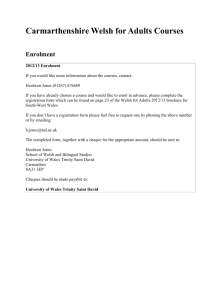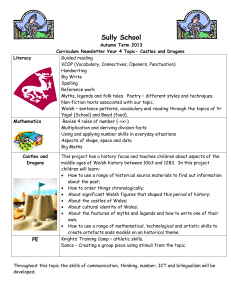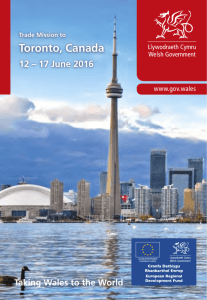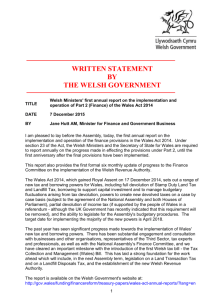PG_Conference - European Centre for Photographic Research
advertisement
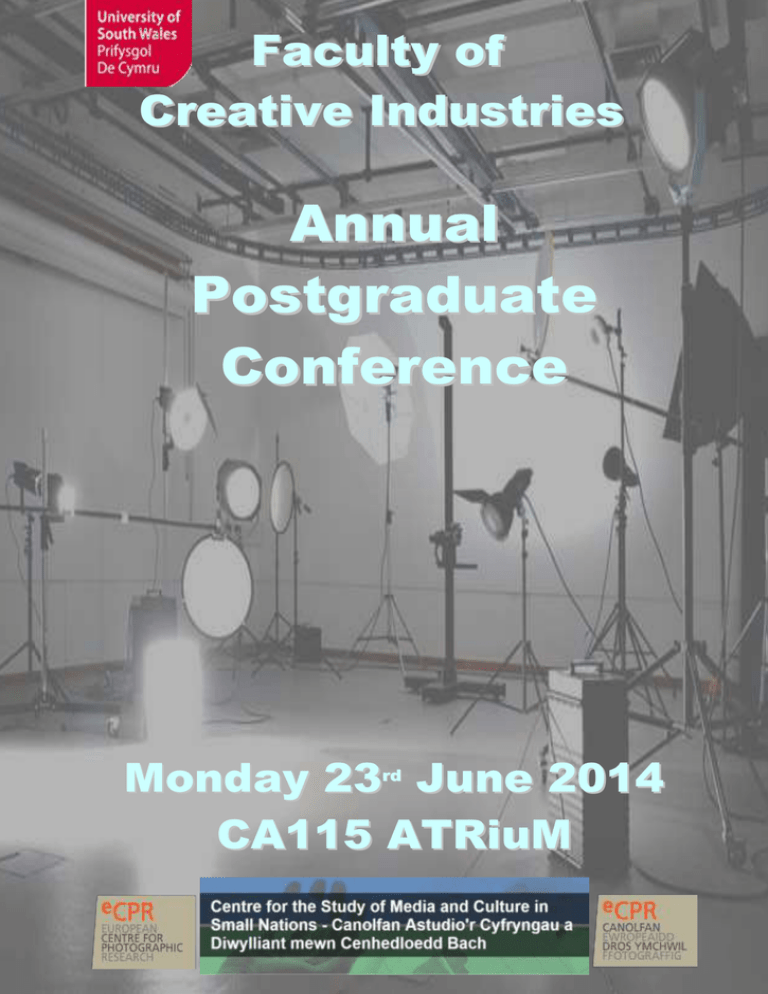
Faculty of Creative Industries Annual P o s tg ra d u a te Conference Monday 23 June 2014 CA115 ATRiuM rd 1 Faculty of Creative Industries Annual Postgraduate Conference 2014 CA115 ATRiuM Monday 23rd June 9:00 Registration Tea and Coffee 9:30 Introduction Dr Ruth McElroy Panel 1: Narratives and Platforms 9:45 11:15 David Langdon Virtual Unreality: The Persistence of the Gothic in Interactive Narrative Julie Benson The Representation of the Female Action Hero in Multi-Platform Narrative João Leal The Impossibility of Non-Narrative Amy Genders The Future of Arts Programming in a Multiplatform Digital Market Chair: Dr Ben Lamb Refreshment Break 11:30 Panel 2: Centre for the Study of Media and Culture in Small Nations 13:00 Siân Powell Reporting Devolution: Blurring the Border between England and Wales Alex Brady Cultural Intermediaries and the Management of National Identity Michael Chronopoulos Ethnic Identity and Greece in Crisis Emyr Davies UFOs and the Public’s Perception of Alien Phenomena Chair: Dr Rebecca Williams Lunch 13:30 Panel 3: Theatre Aesthetics 14:30 Agnes Ka Wing Tai Performativity with Scenography and Model Making Michael Picardie Towards a Philosophy of Theatre Inspired by Aristotle’s Poetics Sarah Crews Wrestling with Text: Performance Practices in Staging Howard Barker Chair: Dr Márta Minier Refreshment Break 14:45 15:30 Panel 4: Musicology Vanessa Dodd The Expressive Quality of Words Chanan Hanspal Zappa and the Orchestral Question Chair: Matthew Lovett Refreshment Break 15:45 Panel 5: European Centre for Photographic Research (eCPR) Martina Cleary George Petry Stephen Todd Les Monaghan 17:00 The Photograph as a Site of Mnemonic Return Philip Jones Griffiths, Photojournalist, Humanist, Welshman Finding a Different Welsh Visual Culture in Amgueddfa Cymru The Triumph of Self Chair: Prof Barry Atkins Close Prof Richard Hand 2 Abstracts 9:45 Panel 1: Narratives and Platforms David Langdon: Virtual Unreality: The Persistence of the Gothic in Interactive Narrative My presentation will outline and explore the progress I have made in answering my research question, ‘How has the Gothic continued to persist in the interactive narrative?’ The Gothic is one of the most varied and interesting presences within literature. Its dedication to reflecting the underlying concerns and desires of society means that it must continually evolve over time to maintain relevancy. Meanwhile, its focus on fear and exaggeration allows it to retain popular appeal whilst still acting as a powerful reflection of its historical moment. Tracing the persistence of the Gothic mode into the present day has the potential to reveal the fears, worries and desires that lie at the heart of modern culture. I have chosen to explore the Gothic in conjunction with the interactive narrative form though a program of theoretical, qualitative research. The form is still in its relative infancy, but my preliminary findings indicate that it is possible to conceive of the interactive narrative as allowing for the development of a new form of Gothic – one centred on collapsing the barriers between audience and art form. The interactive narrative foregrounds audience input, making it a highly appropriate form to capture the anxieties of a culture for whom one of the most major developments has been a revolution in communications technologies. The findings from this research project will prove invaluable to both industry professionals and cultural commentators, as well as experts in the study of literature, as it is my hope that this project will lead to a re-examination of both the Gothic and the interactive narrative as valuable tools for social and cultural dynamism. As can be imagined, exploring the continually updating Gothic mode within a form that is still not fully understood or recognised has proved a challenging and fulfilling experience. Over the course of this presentation I will explore some of these challenges, and explain how I have worked around them to ascertain a decisive link between the Gothic and the interactive narrative. Julie Benson: The Representation of the Female Action Hero in Multi-Platform Narrative This paper discusses the initial research into the representation of the female action hero in multi-platform narrative for the purposes of experimenting with a new model of female hero, as part of the practice-led element of this research. An empirical approach has been taken using a mixed methodology, beginning with a description of the main current models: sex object, proxy male, mother/nurturer and empowered woman, followed by discussion of the approaches to the female hero by modern critics such as Brown (2011), Innes (2004) and Herbst (2004). The paper will go on to describe textual analysis of the first of the female characters to be researched cross-platform, Marvel'sBlack Widow, in film, game and comic. It will highlight key features and conventions of the character, explore how these transfer crossplatform and discuss how Black Widow, in her many forms, fits into existing models. It will also describe audience response to Black Widow, identified through the findings derived from a pilot focus group. Audience response can be useful when attempting to identify attitudes towards women in the media, thus aiding in the creation of future female characters. Initial findings from the pilot group are intended to help inform the planning and creation of a proposed new female character, Red Dragon, a modern-day superhero to feature cross-platform. The practice-led element of the research is to consist firstly of a script for a TV drama series, followed by a video game script featuring same character. A profile of the proposed new hero will be given, along with the initial rationale behind her conception and an outline of the TV drama. João Leal: The Impossibility of Non-Narrative This research is focused on the study of narrative in still and moving images. It’s a qualitative practice-based research and consists on a set of films, photographs, sounds and installations. The practical work will be substantiated by the study of art pieces and writings by a number of artists and theoreticians. The first question I tried to answer was: can a so-called “nonnarrative” work, be truly without a narrative? The answer to this question was an easy one to get: yes it is and there are numerous examples of it. The ones I chose to study were the only film by John Cage One11 with 133 and the work (films, photographs and installations) by two Portuguese artists, João Maria Gusmão and Pedro Paiva. But is it possible to completely escape something that is intrinsic to the human being? Can we say that, when it’s not on the piece itself (still or moving images), narrative is suggested and left to the viewer to process? Or will it appear as a way to convey meaning, to make the work accessible to more people (an element of democratization), to frame the art piece or body of work (a sort of “postconstructed” narrative)? These questions imply a broad understanding of the meaning of “narrative”. We are not looking at it as if it were an easily recognizable, fictional or documental sequence of events with characters. I’m increasingly tending to see it as a kind of an inescapable black hole and I still don’t understand if this is a good or a bad thing. Actually this “black hole effect” is comparable to the process of developing a PhD research. Only in this case, to have the possibility to come out successfully, a person has to be sucked into it. Being so, this research is also about an artist used to produce non-narrative pieces, with varied diegesis, going through the process of structuring a PhD research and reflecting upon it. Amy Genders: The Future of Arts Programming in a Multiplatform Digital Market This study focuses on the ways in which the concept of public service broadcasting (PSB) is articulated through arts programming. Arts programming has traditionally been an important part of fulfilling the purpose of public PSB envisioned 3 by John Reith: to ‘inform, educate and entertain.’ However, the independent media regulator Ofcom found that only 10% of respondents to a nationwide survey thought arts programming was important to society, with only 8% seeing it as a personal priority (2008). These statistics raise questions and concerns about the value of arts programming within today’s television landscape and what can be done to broaden their appeal and engage with contemporary audiences. Through the analysis of production practices and the content of programmes themselves, this study will explore the ways in which arts broadcasting is evolving in an era of niche channelling and multiplatform provision. The present paper serves as an introduction to the project. The first part of the presentation sets out the aims of the project and outlines the progress made so far in defining the research area by mapping both contemporary and historic arts programming. The second part goes on to cover the next step of the research process, briefly discussing the initial stages of creating a literature review and forming a theoretical framework. 11:30 Panel 2: Centre for the Study of Media and Culture in Small Nations Siân Powell: Reporting Devolution: Blurring the Border between England and Wales Since 1999 and the creation of the National Assembly for Wales, the policy differences between England and Welsh have increased in areas such as health and education which has been a challenge for the British media to communicate. Many reports have looked at how devolved matters and the nations of the UK are reported across the nations and regions of the UK (The King Report 2008; Lewis, J et al. 2008. Four Nations Impartiality Review: An analysis of reporting devolution); both these reports have found that the BBC in particular has a London-centric mind-set that has undermined the number of stories regarding devolved matters and how these policies differ within the nations of the UK. This paper forms part of my PhD thesis, which looks at the role of the media during the 2010 General Election and the 2011 Assembly Election in Wales. The main focus of my research is a content and textual analysis of the news and current affairs programmes during both election period and interviews undertaken with journalists and media officers from the political parties within. This paper discusses the initial findings of my PhD including data from my content analysis and interviews and discusses how the differing policies are reported throughout the election campaigns. Alex Brady: Cultural Intermediaries and the Management of National Identity in the Public Faces of Welsh Celebrities Though the term ‘cultural intermediary’ was introduced 30 years ago, describing occupations concerned with presentation, representation and symbolic images assigned to cultural products, services and celebrities (Bourdieu, 2010; Negus, 2002), there still remains much we do not know about the specific working practices of these professions (Edwards, 2012; Negus, 2002). This includes what contributions intermediaries make to debates on national culture and identities (Silk, 2012) and how they select or create celebrities as representatives of nations and their communities (Fan, 2013). The diversity of social and geographic communities in Wales, with their own interpretations of a Welsh national identity, means these debates are ongoing in and important to the nation and whilst Wales and its communities wish to be included in contemporary media, concerns exist about how current contribution from the culture industries may be marginalising or misrepresenting them (Blandford and Lacey, 2011; Williams, 2011). By combining qualitative and quantitative research methods, three questions will be answered, providing a fuller academic insight into contributions intermediaries make to debates on Welsh culture and identity and how national representatives are formed: What elements of Welsh national identities are present in the public faces of Welsh celebrities? What role do cultural intermediaries play in the presence and presentation of these elements? What impact do these elements have upon public celebrity faces? Content and textual analyses of journalistic articles and textual analysis of ancestry programmes will show what elements of Welsh national identities communicate celebrity national identity, how these elements influence public celebrity identities and what images of Wales and its communities these texts transmit. Interviews with intermediaries will establish whether they do manage celebrity national identity, why and how this is done, expanding our awareness of multiple intermediary practices and determining what they find valuable in Welsh national identities for shaping celebrity images. Michael Chronopoulos: Ethnic Identity and Greece in Crisis Ethnic identity (like individual identity ) is not an exclusive immutable essence but a symbolic construct devised to describe the nation and its culture in the process of becoming’. How am I in this thesis describing the nation and its culture in the process of a causal subjective process of 'becoming' as situated and framed upon the nation of Greece in Crisis. The framework of Greece is a very delicate and deeply powerful political and social fragments. I will prove this hypothesis by taking the general notions of gender, political, familial, social and religious within the Greek crisis and pass them through the prism of theoretical approaches of Gender, Performance Theory and Post Colonial Theory In order to understand and try to make sense of a grand narrative, social reality that doesn’t make sense any more in Greece and beyond. Emyr Davies: UFOs and the public’s perception of alien phenomena: Re-visiting the Dyfed Triangle of 1977 The year 1977 played host to a wave of UFO (unidentified flying object) sightings across South West Wales. People from all over the county of Dyfed, children and adults, were witness to alien phenomena. The strange happenings included sightings of mysterious lights and objects in the skies and on the ground and encounters with 7ft tall silver beings. This episode of alien phenomena became known as The Dyfed/Welsh Triangle (Paget: 1979). The reasoning behind the 4 infamous title ‘The Dyfed/Welsh Triangle’ emerged when the majority of alien phenomena manifested itself in an area between Broad Haven, Milford Haven and Haverfordwest. If one were to link all three locations on a map a triangle would emerge. The alien phenomenon of 1977 was first documented by Paget (1979), Harold (1979) and Pugh & Holiday (1979). The current project, unlike its late 1970s predecessors which conducted interviews with eye-witnesses, analyses news reports concerned with Dyfed’s alien phenomena from four local print media publications across the year 1977. The four publications under analysis are the Western Telegraph, Western Mail, Tivyside Advertiser and Pembroke County Guardian & Cardigan Reporter. 65 news reports including readers’ letters, across all four publications, were concerned with the alien machine sightings of West Wales. The analysis delves into the way in which eye-witnesses describe and interpret what they have seen. The research is most interested in what reference material, if any, these witnesses use when describing their unusual experiences. The project also examines the way in which the publications themselves reported upon the alien phenomena. It should be noted, the term ‘alien machine’ will be used as an alternative to UFO, and the alien entity will be known as ‘the organic alien’. 13:30 Panel 3: Theatre Aesthetics Agnes Kai Wing Tai: Performativity with Scenography and Model Making ‘I like things that have passed through human hands. Things that have been touched. Such things are charged with emotions that are capable of revealing themselves under certain, extremely sensitive circumstances.’ (Švankmajer, 2011) This PhD is a practice-as-research project to examine how time and space are signified in scenography models. The objective is to give an insight on the purpose of the scenography model and what is beyond its craftsmanship and technical aspects, which are being interpreted as a translating tool or a step in a thinking process. It is a topic that is seldom examined but yet many times you see a scenography model being displayed in museums and exhibitions as an object that represents the memory of a performance and something that the performance has left behind. This research is going to explore the journey of a scenography model, the transformation and performance that occurs in the construction of the model and the afterlife of the scenography model. This thesis proposes and argues that the scenography model can be a performance itself depending on its interaction with spectator, one can assume that it is already being recognised as an art form due to its existence in museums and galleries. However, I would argue that the scenography model is seen as an information and additional object of a performance, and the spectator often fails to perceive the importance and meaning behind it. By investigating the theoretical concepts of performativity, liveness within scenography, humanity geography and miniature, as well as examining the works of practitioners in related fields such as stop-motion animation and miniature art, I can then analysis the relationship between scenography and the spectator to support my proposition on the existence of performativity in the scenography model. Michael Picardie: Towards a Philosophy of Theatre Inspired by Aristotle’s Poetics and Post-Structuralist Aesthetics in Relation to Three South African Plays I have attempted a reading of Aristotle in terms of mimesis, ethos, mythos, lexis, hamartia, anagnorisis, peripeteia, catharsis and anamnesis - as an existential “being-there” (Dasein) of the characters’ freedom and actual historicity - in three of my plays in which I performed or witnessed in productions in England, Wales, three Scandinavian countries, the U.S. and South Africa. I have analysed other Southern African “womanist” performative drama and and feminist theatre. I assume with the ancient Greeks that in serious theatre there is theoria, an educated, discursive looking, which involves a dialectics of logos in dianoia intertwined in the mythos – ethical truth in the discourse of the plot. Whilst aesthetics cannot be reduced to psycho-biography, creative writing is motivated in part by the author’s and the dramatic subjects’ psychoanalytically understood personal and political unconscious placed in the ethos – the character on the stage. The aesthetics of tragedy relate to both peripeteia (reversals) and anagnorisis (recognition of responsibility) which occur within an arc of development, crisis and denouement of the vicissitudes of purported wisdom in understanding how performative drama and critical theatre have been presented in what has become known as The Struggle in a post-apartheid South Africa and post-colonial Zimbabwe by comparison with historical conditions in South America, India, even China. The values of nous, phronesis and sophia, intuitive, practical and interpretative wisdom are connected to the Nicomachean and Eudemian Ethics with which the tragic-comic hero and his Other are imbued or violate. The post-structuralist aesthetic as developed in the literary theory of the twentieth century is essentially the interaction of synchronic and diachronic language emerging from the signifiance and the semiosis of the chora (the feminine or maternal unconscious) within the de-familarisation techniques of Russian and Czech Formalism. This provides a creative and meaningful limit to a consciousness of being-white and being-black-in-the-world against disempowering Nothingness or perceived Otherness threatening moral beings. Nothingness and the Other are characterised magically and as witch-craft in oral-cultures which deny the unconscious and resort to paranoia and persecution of Otherness in the subject projected onto the other – the “colonial personality”. 5 Sarah Crews: Wrestling with text: performance practices in staging Howard Barker’s Theatre Aesthetics My doctoral research investigates emerging subject positions in drama and performance studies that challenge traditional concepts of the theatre director. Now in the final stages of my PhD, this presentation will reflect on the demands and challenges I have faced in undertaking practice as a research methodology. Practice and performance as an outcome of research is a concept that remains contested across institutions in the HE sector globally; my research offers a significant contribution to emerging studies in theatre making and methodological frameworks for practice as research that draw on my own theatre practice in directing the plays of Howard Barker. Barker’s position in cotemporary European theatre studies locates him as a notoriously complex and demanding playwright however my theatre practice investigates the freedom and constraints of his contemporary plays: this concept was addressed in the staging of Barker’s Ursula Fear of the Estuary in 2014. Performed in the gallery space at the Riverfront Theatre, Newport, the production involved a cast of undergraduate students and investigated the demands of staging the theatricality of Barker’s play through the lens of the Viewpoints methodology. Viewpoints is a system of actor training that provides a series of tangible exercises for encouraging collaborative working practices; referred to by director Anne Bogart as an ‘open methodology’, the philosophy of Viewpoints aims to discover ‘what the play wants’ rather than assuming the director as the creative authority. Viewpoints and Barker would be seen as incompatible within theatre studies, because Viewpoints is commonly associated with improvisational performance practice. I argue, though, that the application of Viewpoints techniques responds to the demands of Barker’s writing as they share a philosophy for artistic practice that resists logic and cognition as driving forces. 14:45 Panel 4: Musicology Vanessa Dodd: The Expressive Quality of Words This paper, using theories of musical form, content and tone as a critical approach, looks at how an aspect of (waking) consciousness, namely emotional states are expressed in the contemporary play. A sample of plays by women playwrights will be explored as examples: how sadness is conveyed in the lyricism of the lines in April de Angelis’ The Iron mistress and how despair and mental breakdown is expressed through patterning on the page in Sarah Kane’s Psychosis 4.48 and if time how Phyllis Nagy uses musical structure ( the twelve tone system of Schoenberg) as an underpinning design in her play Disappeared giving expression to puzzlement and ambiguity, The paper concludes that for scriptwriters understanding words as the organisation of sound, equivalent to the organisation of sound in music can communicate emotional states and is a means whereby the writer can control textual tone. Chanan Hanspal: Zappa and the Orchestral Question My research investigates the unique approach of composition in Zappa’s orchestral pieces and why hitherto it has been largely overlooked. There are two reasons for neglect, the first is attributable to the difficulty of acquiring the orchestral scores, as the only way to view them is by rental from a publishing company at an exorbitant price. The second reason is that much of new musicology places emphasis on the interpretation as opposed to the structural aspects of music. Structural analysis is deemed to make sense only to analysts or competent listeners and that we should consider the cognitive effects of the general listener, but I argue that it is the competent listener who is listening to this music and not the general listener. Therefore, the structural approach still holds significance, especially in understanding the process of how a composer draws musical resources together to create a unique sound. The research so far has revealed a number of interesting discoveries about how Zappa constructed his orchestral music. Using a variety of analytical techniques, it appears that there are habitual tendencies of the composer across a number of the pieces, and these compositional tendencies are what this presentation will outline. Clement (2009) has already discovered an important technique which is the application of dense chords that are assembled systematically by a process Zappa referred to as the “Chord Bible”. This is where chords are employed that contain the simultaneous voicing of 7 to 8 non-repeating notes creating a dense-like sound that is either static or moves in rapid succession in a homo-rhythmic form. Another important component is a technique called “Isomelism” which is when a melody is repeated containing the same notes but is rhythmically modified. I shall discuss these processes and demonstrate with audio recordings and music notation slides. 15:45 Panel 5: European Centre for Photographic Research (eCPR) Martina Cleary: The Photograph as a Site of Mnemonic Return, Visual Strategies for Using the Photograph to Preserve, Construct and Trigger Memory. The background and context of this research is inspired by questions emerging from my own practice as a visual artist, in which I use archival photographic sources as a starting point to examine interrelationships between the image, place and memory. Using qualitative research methods, including practice-based research, aesthetic evaluation and visual ethnographic strategies, my concern is in examining how the photograph functions as a reflexive site of mnemonic return, as a trigger, or route to recollection. What is it exactly within a photographs material form, aesthetic construction, or medium specificity that enables such potential? In this paper, I will address these questions through a critical examination of key images created by Dorothea Lange during her work for Life magazine in Ireland, in 1954. I will discuss Lange’s visual and conceptual approach to her subject, and how her images resonate with recurring motifs and tropes, which have been 6 used to define, construct and consolidate memories of the rural West of Ireland. In analysing Lange’s work, I will be examining the influence of Conrad Arnsberg’s anthropological study of 1937 on how she approached her subject. I will also be drawing upon recent writings by Dr. Justin Carville, on photographic visual ethnographies in the Irish context, and his critique of this particular body of Lange’s work as sympathetic, documentary humanism. I will also be referencing a recent interview I have conducted with Gerry Mullins, the journalist and writer who published the first comprehensive overview of Lange’s work in Ireland, in 1996. Finally, in identifying certain aesthetic and conceptual strategies in operation within Lange’s work, I will consider how similar methods may be applied within my own photographic research, in which I am currently retracing, reconstructing and deconstructing selected subjects and motifs from Lange’s original journey. George Petry: Philip Jones Griffiths, Photojournalist, Humanist, Welshman: Why Wales should celebrate his contribution to contemporary history. Since his death in 2008, academic interest in photographer Philip Jones Griffiths has grown. The project aims to examine the Griffiths archive held by the National Library of Wales, focusing specifically on the America-Vietnam War (1966-71) segment contents. The archive will be evaluated through close reading and analysis of Griffiths’ 1971 seminal book Vietnam Inc. from which it was created. This paper will consider how Vietnam Inc. presents aspects of the war as Griffiths saw and reported it in photographs and narrative, his views on the cultural and hegemonic destructiveness of US government policy on the Vietnamese people, compared with other war photographers. Proud of his Welsh roots and culture, Griffiths related to the Vietnamese and their rural way of life, outraged at what he saw as US military and cultural imperialism intimidating and ultimately seemingly aiming to destroy traditional Vietnamese culture. He connected his perceptions with English imperialism and the historic treatment of Wales by England over the last 900 years. Vietnam Inc. can be regarded as a powerful humanist indictment, if also a lonesome, trenchant voice, against US cultural foreign policy in Vietnam. The Research Hypothesis posits whether it is reasonable to believe that a photographer born in 1930s North Wales, could carry that area’s cultural notion of Welshness, as a memory influencing his views on life and therefore the composition and choices of subject in his photographic work - through war and the suffering of the people of an alien country, namely Vietnam. Running alongside the critical and qualitative analysis, will be a “permanently-on” Welshness Filter, seeking indications and evidence of any form of Welsh cultural influence in the composition and presentation of photographs. The ‘Welshness Filter’ will be a broadly defined, generally uncontentious assembly of cultural Welshness characteristics. Seeking Welshness as a cultural characteristic, which may or may not be evident in Griffiths’ war photographs is a risky approach, yet considered essential to properly validate the work of this extraordinary photographer. Stephen Todd: Finding a Different Welsh Visual Culture in Amgueddfa Cymru- National Museum Wales I am researching the roles of photography within the cultural histories of National Museum Wales. To help piece together the mosaic of photographic support in Wales, I intend to discuss photographs as evidence. Early in the Museum’s history, two photographic surveys were commissioned by the Cardiff Naturalists Society, a group which supported the creation of National and Cardiff Museums. The allotropic nature of photography, combined with AC-NMW’s broad mission and multidisciplinary structure, created an environment in which images and archives routinely shift between departments, which frequently used different standards for catalogues, storing and data-management. This represents a fundamental trait of photography; it is a medium of multiple uses and interpretations, with ever changing interactions to other disciplines. For example, though the 1890 and 1912 surveys of Glamorganshire and Wales were regarded as achievements for Welsh social and architectural history, as well as defining characteristics for growing Welsh Nationalism, the continued compartmentalization for photography at AC-NMW would splinter the potential role for photography within the Museum. Much of this splintering comes as a result of the museum chasing undefinable “authentically Welsh” collections. As a result, social history photography shifts to an internal documentation, rather than an external communication, and the Geology department, followed by the Industry Department in 1959, become the main arenas for support and promotion of photography. In turn, photographic visual culture is bound within the narrative of industrial history. This is the role that I wish to discuss; photography as either internal or external communication, as it pertains to AC-NMW, and the understanding of the pursuit of “Welshness,” as potentially detrimental for the photographic collection and social history of Wales. Les Monaghan: The Triumph of Self This research centres around the use of documentary photography, both posed and unposed to investigate facets of living in contemporary Britain. Using the people and town of Doncaster in South Yorkshire my intention is to photograph what John Berger calls, 'the pain in the world'. Doncaster is a post industrial town at the epicentre of the former South Yorkshire coalfield, despite its credentials as a Labour town it is illustrative of what Julian Baggini has termed communitarianism – his 'Everytown' is in the neighbouring postcode. I would argue that it is post- socialist, the recent lurch to the English Democrats and UKIP demonstrate an individualist outlook among many of its varied citizens. 7

